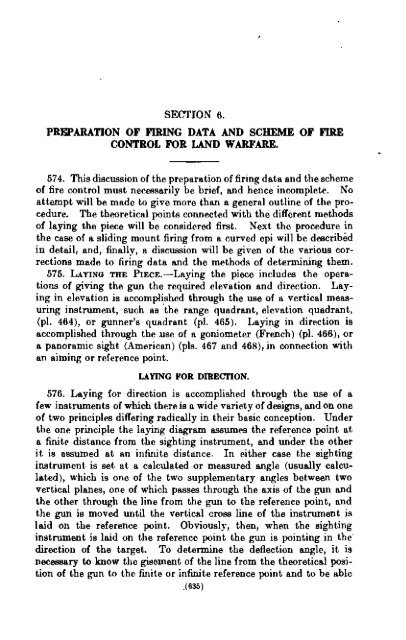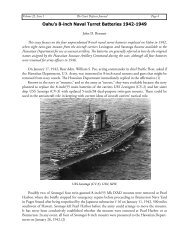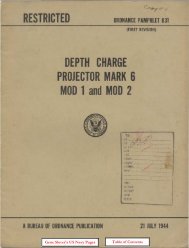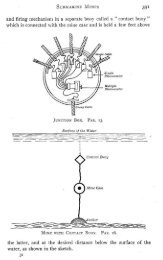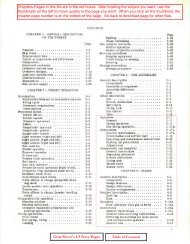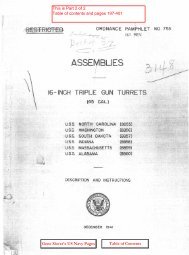...Railway artillery - Personal Page of GENE SLOVER
...Railway artillery - Personal Page of GENE SLOVER
...Railway artillery - Personal Page of GENE SLOVER
You also want an ePaper? Increase the reach of your titles
YUMPU automatically turns print PDFs into web optimized ePapers that Google loves.
SECl'ION 6.<br />
PREPARATION OF FIRING DATA AND SCHEME OF FIRE<br />
CONTROL FOR LAND WARFARE.<br />
574. This discussion <strong>of</strong> the preparation <strong>of</strong> firing data and the scheme<br />
<strong>of</strong> fire control must necessarily be brief, and hence incomplete. No<br />
attempt will be made to give more than a general outline <strong>of</strong> the procedure.<br />
The theoretical points connected with the different methods<br />
<strong>of</strong> laying the piece will be considered first. Next the procedure in<br />
the case <strong>of</strong> a sliding mount firing from a curved epi will be describedin<br />
detaill and, finally, a discussion will be given <strong>of</strong> the various corrections<br />
made to firing data and the methods <strong>of</strong> determining them.<br />
575. LATING THE PlEcE.-Laying the piece includes the operations<br />
<strong>of</strong> giving the gun the required elevation and direction. Laying<br />
in elevation is accomplished through the use <strong>of</strong> a vertical measuring<br />
instrument, such as 'the range quadrant, elevation quadrant,<br />
(pI. 464), or gunner's quadrant (pI. 465). Laying in direction is<br />
accomplished through the lIse <strong>of</strong> a goniometer (French) (pI. 466), or<br />
a panoramic sight (American) (pIs. 467 and 468), in connection with<br />
an aiming or reference point.<br />
LAYING FOR DIRECTION.<br />
576. Laying for direction is accomplished through the use <strong>of</strong> a<br />
few instruments <strong>of</strong> which there is a wide valjety <strong>of</strong> designs, and on one<br />
<strong>of</strong> two principles differing radically in their ba!3ic conception. Under<br />
the one principle the laying diagram assumes the reference point at<br />
a finite distance from the sighting instrument, and under the other<br />
it is assumed at an infinite distance. In either case the sighting<br />
instrument is set at a calculated or measured angle (usually calculated),<br />
which is one <strong>of</strong> the two supplementary angles between two<br />
vertical planes, one <strong>of</strong> which passes through the axis <strong>of</strong> the gun and<br />
the other through the line from the gun to the reference point, and<br />
the gun is moved until the vertical cross line <strong>of</strong> the instrument is<br />
laid on the reference point. Obviously, then, when the sighting<br />
instrument is laid on the reference point the gun is pointing in thedirection<br />
<strong>of</strong> the target. To determine the deflection angle, it is<br />
necessary to know the gisement <strong>of</strong> the line from the theoretical position<br />
<strong>of</strong> the gun to the finite or infinite reference point and to be able<br />
,(635)<br />
Digitized by Coogle


